Lifestyle
Space Hero Extraordinaire: Elon Musk
Anyone that can break the cycle of bureaucracy and nay-sayers to get a country focused on things that are super important, things like clean energy and planetary exploration, is a hero in my book. For Elon Musk and the few others like him, wanting something “too bad” isn’t a weakness because the very things you want require that kind of commitment to be attainable. The proof of that concept? Four words: “The Falcon has landed.”
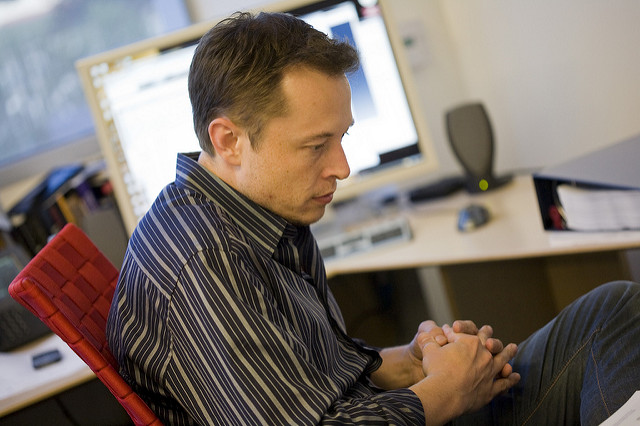
Just Another Dreamer
When I was a kid, I wanted nothing more in the world than to be an astronaut. I just knew it was my “calling”. I fed my space addiction as much as the school’s library would allow me to, and I couldn’t even fathom why every other kid in my grade didn’t want the same thing. I still remember laughing when one of them said he didn’t know who Neil Armstrong was, thinking it was a joke, and then being completely floored when he asked me why he should care about some “old” dude.
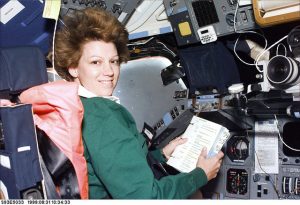
Columbia Commander Eileen Collins by NASA on The Commons is provided with no known copyright restrictions.
I was a total geek. I have no problem admitting that. I had even managed to convince my parents to send me to Space Camp in Huntsville, Alabama where I was selected to be my session’s shuttle commander. This was years before Eileen Collins had become the first female shuttle commander, so it was a big deal to me.
One day, another student told me that I would never become an astronaut because I wanted it “too bad”. I still hate that she was right, but I really can’t hate the reasons why it came to be true. Genetics are genetics, and not meeting a five-foot-four threshold combined with not having twenty-twenty vision are more or less non-starters for the space cowboy wannabes out there. Then life happened, I went down another path (or seven), and the shuttle program was shut down before I ever got the opportunity to see a launch in person.
Mars and Musk for the “Win”
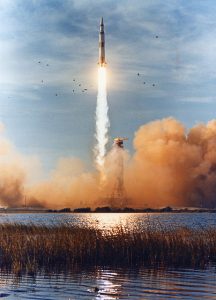
Apollo 8 Liftoff View by Project Apollo Archive is provided as part of the public domain.
When I finally made it to the Kennedy Space Center in Florida, it was the same week the very last shuttle had landed. As I stood in the bleachers where hundreds of others had sat to watch rockets take to the sky, gazing out at the launch pad that had held so much human spirit on it, I suddenly felt it again. The “calling”, renewed now with a slightly different purpose. Then I turned to my mostly disinterested brother and said, “Mike, this is my manifesto. One day, I’m going to be part of the effort that takes man to Mars. I got here too late for the moon and too late for the shuttle, but I’m not gonna give up. It’s too much a part of who I am, even today.” He laughed at me, of course, and probably rolled his eyes, but I wasn’t watching him. I was dreaming again.

The Final Shuttle by Brent Newhall is licensed under CC by 2.0.
That’s where Elon Musk came in for me. Cool rich guy does cool stuff with his money in an attempt to go cool places with his rockets, right? No, not really. It wasn’t that simple. I will even admit it took me a fairly long time to actually follow what he was doing. The words “commercial” and “space” just didn’t really mesh well together in my head. What could a business mentality really bring to the spirit of human space exploration that was pure enough to be worthy?
It took an interview with Elon on an episode of StarTalk Radio, hosted by Neil DeGrasse Tyson (your personal astrophysicist), to finally “get” what was special about him. This guy’s main concern in life was advancing humanity. It really seemed to me that money was a means to an end for him, not the end itself, and that was something I could respect in a big way. After that, it didn’t take very long for fascination to set in, and now I consider him to be one of my heroes.
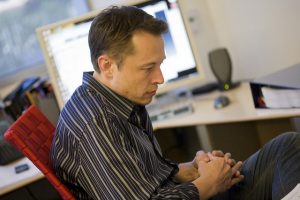
OnInnovation Interview: Elon Musk by OnInnovation is licensed under CC by ND 2.0.
“Hero” is a word that tends to be thrown around a lot, but I think in this case it is definitely deserved. It’s about breaking the cycle. The space industry is heavy with bureaucracy, inefficiency that drives high costs, and “big guys” happy to stand in the way of any other “guys” hoping to get in on the action. New technology means less job security for those doing things the way it has always been done, and long-standing relationships between the “big guys” and NASA have kept the “little guys” focused mostly on space tourism rather than pure scientific pursuit or pushing the boundaries of what can be done and where we can go.
Elon Musk: Space Hero Extraordinaire
Enter Elon Musk with SpaceX. He decides he’s going to launch rockets that are better, cheaper, flown more often, and with Mars as the ultimate goal. Shockingly, it doesn’t entirely even matter to him whether he succeeds or not. It’s just that important and must be tried. He didn’t get into the space business to make money; he got in for sake of all of us.

Exploration Imagery by NASA on The Commons is provided with no known copyright restrictions.
To be fair, Elon is not entirely unique in his desire to explore other planets, especially Mars. I remember watching an IMAX film during my week at Space Camp that had fantastic visuals explaining how we could terraform our red neighbor. I even remember thinking, “Oh, great! We do have a plan.” In reality though, we didn’t have a plan, or at least didn’t until Elon’s effect inspired people to demand one.
Anyone that can break the cycle of bureaucracy and nay-sayers to get a country focused on things that are super important, things like clean energy and planetary exploration, is a hero in my book. For Elon Musk and the few others like him, wanting something “too bad” isn’t a weakness because the very things you want require that kind of commitment to be attainable. The proof of that concept? Four words:
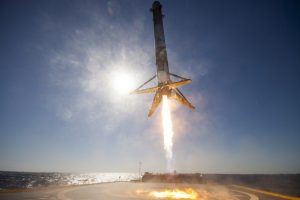
CRS-8 first stage landing by SpaceX is part of the public domain.
“The Falcon has landed.”
So that’s my angle, my two cents – whatever you want to call it. With SpaceX and Elon taking so much initiative, our future in the final frontier is finally happening again, and I am excited to both have the opportunity to watch everything unfold and to share my thoughts as it happens. I do plan on joining the effort directly, but more on that later. For now, the headlines are filled with the “next steps”, and there’s much to be said about them.

Lifestyle
Tesla Model S Plaid battles China’s 1500 hp monster Nurburgring monster, with surprising results
There is just something about Tesla’s tuning and refinement that makes raw specs seem not as game-changing.

The Tesla Model S Plaid has been around for some time. Today, it is no longer the world’s quickest four-door electric sedan, nor is it the most powerful. As per a recent video from motoring YouTube channel Carwow, however, it seems like the Model S Plaid is still more than a match for some of its newer and more powerful rivals.
The monster from China
The Xiaomi SU7 Ultra is nothing short of a monster. Just like the Model S Plaid, it features three motors. It also has 1,548 hp and 1,770 Nm of torque. It’s All Wheel Drive and weighs a hefty 2,360 kg. The vehicle, which costs just about the equivalent of £55,000, has been recorded setting an insane 7:04.957 at the Nurburgring, surpassing the previous record held by the Porsche Taycan Turbo GT.
For all intents and purposes, the Model S Plaid looked outgunned in Carwow’s test. The Model S Plaid is no slouch with its three motors that produce 1,020 hp and 1,420 Nm of torque. It’s also a bit lighter at 2,190 kg despite its larger size. However, as the Carwow host pointed out, the Model S Plaid holds a 7:25.231 record in the Nurburgring. Compared to the Xiaomi SU7 Ultra’s record, the Model S Plaid’s lap time is notably slower.
Real-world tests
As could be seen in Carwow’s drag races, however, Tesla’s tech wizardry with the Model S Plaid is still hard to beat. The two vehicles competed in nine races, and the older Model S Plaid actually beat its newer, more powerful counterpart from China several times. At one point in the race, the Xiaomi SU7 Ultra hit its power limit due to its battery’s temperature, but the Model S Plaid was still going strong.
The Model S Plaid was first teased five years ago, in September 2020 during Tesla’s Battery Day. Since then, cars like the Lucid Air Sapphire and the Xiaomi SU7 Ultra have been released, surpassing its specs. But just like the Model Y ended up being the better all-rounder compared to the BYD Sealion 7 and the MG IM6, there is just something about Tesla’s tuning and refinement that makes raw specs seem not as game-changing.
Check out Carwow’s Model S Plaid vs Xiaomi SU7 drag race video below.
Lifestyle
500-mile test proves why Tesla Model Y still humiliates rivals in Europe
On paper, the BYD Sealion 7 and MG IM6 promised standout capabilities against the Model Y.

BYD is seeing a lot of momentum in Europe, so much so that mainstream media has taken every opportunity to argue that the Chinese automaker has beaten Tesla in the region. But while BYD sales this year in Europe are rising and Tesla’s registrations remain challenged, the raw capabilities of vehicles like the Model Y are difficult to deny.
This was highlighted in a 500-mile challenge by What Car? magazine, which showed that the new Tesla Model Y is more efficient, cheaper to run, and more reliable than rivals like the BYD Sealion 7, and even the nearly 400 KW-charging MG IM6.
Range and charging promises
On paper, the BYD Sealion 7 and MG IM6 promised standout capabilities against the Model Y. The Sealion 7 had more estimated range and the IM6 promised significantly faster charging. When faced with real-world conditions, however, it was still the Model Y that proved superior.
During the 500-mile test, the BYD nearly failed to reach a charging stop, arriving with less range than its display projected, as noted in a CarUp report. MG fared better, but its charging speeds never reached its promised nearly-400 kW charging speed. Tesla’s Model Y, by comparison, managed energy calculations precisely and arrived at each stop without issue.
Tesla leads in areas that matter
Charging times from 25% to 80% showed that the MG was the fastest at 17 minutes, while Tesla and BYD were close at 28 and 29 minutes, respectively. Overall efficiency and cost told a different story, however. The Model Y consumed 19.4 kWh per 100 km, compared to 22.2 for MG and 23.9 for BYD. Over the full trip, Tesla’s charging costs totaled just £82 thanks to its supercharger network, far below BYD’s £130 and MG’s £119.
What Car? Magazine’s testers concluded that despite BYD’s rapid sales growth and the MG IM6’s seriously impressive charging speeds, Tesla remains the more compelling real-world choice. The Model Y just offers stability, efficiency, and a proven charging infrastructure through its Supercharging network. And as per the magazine’s hosts, the Model Y is even the cheapest car to own among the three that were tested.
Watch What Car? Magazine’s 500-mile test in the video below.
Lifestyle
Tesla Cybertruck slapped with world’s least intimidating ticket, and it’s pure cringe
One cannot help but cringe and feel second-hand embarrassment at the idea of a person just driving around with a stack of these babies.

A Cybertruck parked at Stanford Shopping Center in California was recently hit with what might be the most try-hard piece of paper ever slipped under a wiper blade: a “fake citation” accusing the driver of supporting a “fascist car.”
The note, shared on X by Tesla staff program manager Ryan Torres, quickly made the rounds on X, where it quickly gained attention as an example of how not to protest.
The world’s least intimidating ticket
According to the citation, the supposed “violation” was “driving a fascist car.” The remedial action? Take the bus, call an Uber, or ride a bike. The note also dubbed Elon Musk a “chainsaw-wielding Nazi billionaire.” Now, protests against Tesla and Elon Musk have become commonplace this year, but one cannot help but cringe and feel second-hand embarrassment at the idea of a person just driving around with a stack of fake anti-Tesla/Musk citations.
Torres pointed out the irony himself in his post on X. Tesla currently employs over 140,000 Americans, and SpaceX has put the U.S. firmly back at the top of space technology. As Torres put it, maybe the person behind the world’s least intimidating ticket should “read a book on innovation before vandalizing” other people’s property.
Peak performative clownery
Not to mention that the fake ticket’s logic collapses under its own weight. EVs like the Cybertruck are literally designed to reduce emissions, not “destroy the economy.” If anything, Tesla has bolstered the United States’ economy by fueling jobs in engineering, manufacturing, and clean energy. It’s not the first time a Tesla has been the target of vandalism or politically charged notes, but this one stands out for sheer cringe value.
Torres summed it up neatly: “Peak clownery.” On that point, at least, the citation earns full marks. In a way, though, perhaps cringe fake tickets are not as bad as the literal firebombs that were being thrown at Tesla stores and cars earlier this year because some critics were gleefully misinformed about Elon Musk.








